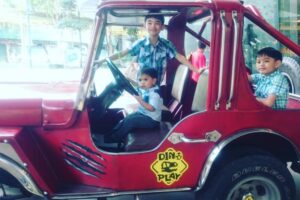We had another field trip last April at Rizal Park. This is the third time for our two older children. But it was only the second time for our youngest child. The very first time that I brought my children to Rizal Park, my second child was still a toddler and my eldest was around 5 years old. Also, at that time, we only had a picnic at the Chinese Garden, had our photo taken at Rizal’s monument, and rode a tram/train around the park.
Our second visit was last year in June with my husband. It was just a quick visit. We had our photos taken at Rizal’s monument again and at the big flagpole. It was also drizzling at that time. After that, we went to other monuments in Cavite. You may read about it here.
Now that the children are older and understand more about our history, I want our family to visit the different parts of Rizal Park as part of our History (Araling Panlipunan) lessons. This way, they do not only see details in a book but also see places and monuments related to our lessons. Hopefully, this strategy would help them remember more and remember details longer.
Since we celebrate Araw ng Kagitingan in April, I thought that it would be a good time to go back to Rizal Park to learn more about our brave and noble heroes. So we went there during one of the long weekends in April.

The 3 main things that I wanted us to see during this visit were the life-sized dioramas on the heroism of Dr. Jose Rizal, the GomBurZa monument and the statues of heroes on both sides of the Dancing Fountain of Rizal Park.
The Martyrdom of Dr. Jose Rizal/Ang Pagpapakabayani ni Dr. Jose Rizal

The statues depicting the execution of Dr. Jose Rizal at Rizal Park evoke a poignant and powerful reflection on the ultimate sacrifice made by the national hero. Captured in a somber and dramatic scene, the statues depict Rizal standing before a firing squad, his face calm and resolute in the face of imminent death. This poignant representation serves as a reminder of Rizal’s unwavering commitment to the cause of Philippine independence and his unwavering belief in the power of knowledge and peaceful resistance.

The statues capture the solemnity and significance of that fateful day, igniting a profound sense of reverence and admiration for Rizal’s bravery and the enduring impact of his martyrdom. As visitors behold these statues, they are moved to reflect upon the sacrifices made by Rizal and the countless individuals who fought for the nation’s freedom, leaving an indelible mark on the collective memory of the Filipino people.


There was a tour being conducted by a big group of students, probably high school or college students. So, we got to hear some parts of the lecture by their tour guide or professor. One of the interesting details mentioned by the lecturer to the students on the tour is that Dr. Jose Rizal was calm and dignified as he faced his death. Another detail highlighted was that the drum and bugle group was asked to accompany him to his place of execution and to signal his execution. This meant that the one who will be executed is an important person.

Aside from the life-sized dioramas depicting the execution of Dr. Jose Rizal and some scenes leading to his execution, there was a big wall where his Mi Ultimo Adios could be read.

GomBurZa Monument/Marker
The monument of Gomburza stands as a solemn tribute to three Filipino priests: Fathers Mariano Gomez, Jose Burgos, and Jacinto Zamora. Collectively known as Gomburza, they were unjustly accused and executed during the Spanish colonial period in the Philippines. The monument serves as a reminder of their unwavering commitment to the Filipino people and their fervent advocacy for social justice and reforms within the Church. Gomburza’s martyrdom played a significant role in awakening national consciousness and fueling the fires of revolution against Spanish oppression. Their monument stands tall, symbolizing their sacrifice and the enduring spirit of resistance that continues to inspire generations of Filipinos striving for a just and free society.

The monument for the 3 priests is small compared to Rizal’s monument. But it is near Rizal’s monument. It is between the area where the dioramas are and where you will see the tall flagpole.
Statues of Heroes at the Musical Dancing Fountain/Central Lagoon
On the 2 long sides of the Dancing Fountain, there are numerous statues of Filipino heroes. On each statue also are some details or important facts/contributions about each hero. We asked our kids to alternately read the writings on each statue. We tried to make associations, too, that will help all of us remember them.

The statues of heroes encircling the dancing fountain at Rizal Park stand as majestic guardians, embodying the valor and indomitable spirit of the Filipino people. Each statue, meticulously crafted and positioned, pays homage to renowned figures who have played pivotal roles in shaping the nation’s history and inspiring generations. Standing tall and proud, they serve as timeless reminders of courage, sacrifice, and unwavering determination.

After reading about the lives of the heroes while going around the fountain area, the boys rode their bikes and biked around the park. It was challenging for them to bike because there were many people in the park that day since it was a holiday. I also made sure that I could still see them where they were biking. I also instructed the older boys to stay close to their youngest brother while biking.

It was already slowly getting dark when our boys finished biking. The Musical Dancing Fountains’ lights were already on by then. It’s relaxing to watch them while eating your picnic food. Many people had their picnic mats on the grass around the fountain area already.
Thus, we had our picnic at one of the picnic tables at the Noli Me Tangere Garden. There are a lot of food stalls in the area. You will not really go hungry while visiting Rizal Park. But it is still best to bring your own food and water in case you don’t like the food you’ll find there and if you want to save money. During our visit, there were people selling the usual Filipino merienda/snacks like turon, bananacue, and gulaman at sago. There was also an ice cream vendor (Mamang Sorbetero).

When I was a child, I remember going to Rizal Park with my parents and younger brother a lot to have picnics there on Sundays.
Because Rizal Park is huge, I suggest that you visit the different parts of it on separate occasions, especially if you have young children who get tired easily. It spans an area of approximately 58 hectares (or 143 acres). below is a map of the entire Rizal Park.

My plan is that on our next visit, we will check out the Chess Plaza, the Japanese Garden, and the big Philippine Map on the other end of Rizal Park. If we have more time, maybe we would also let the kids play at the kids’ playground.
My 2 main tips for families are: 1. to bring extra clothes and face towels because you will definitely sweat walking around and 2. visit during weekdays if you can so that the park would not be crowded. It is best to visit during the early morning before 10 AM and 4 PM onwards.
As usual, it was another fun-filled day of exploring Rizal Park with our kids. It was an opportunity to be with nature and enjoy playing in a big open space.
I highly recommend field trips to Rizal Park whatever your age. It’s a wonderful place to learn and relearn our country’s history and culture. There are a lot of cultural events scheduled there and entrance is usually free. You may follow this Facebook page to get updates and details. That’s one of the things I want our family to do in the future. Most of these events are staged at the Open Air Auditorium of Rizal Park.










Leave a Reply
Your email is safe with us.